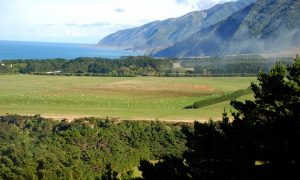
On 27 June, lava from Kīlauea, an active volcano on the island of Hawai`i, began flowing to the northeast, threatening the residents in Pāhoa, a community in the District of Puna, as well as the only highway accessible to this area. Scientists from the U.S. Geological Survey’s Hawaiian Volcano Observatory (HVO) and the Hawai`i County Civil Defense have been monitoring the volcano’s lava flow and communicating with affected residents through public meetings since 24 August. Eos recently spoke with Michael Poland, a geophysicist at HVO and a member of the Eos Editorial Advisory Board, to discuss how he and his colleagues communicated this threat to the public.
Drilling a Small Basaltic Volcano to Reveal Potential Hazards
Drilling into the Rangitoto Island Volcano in the Auckland Volcanic Field in New Zealand offers insight into a small monogenetic volcano, and may improve understanding of future hazards.
From AGU’s journals: El Niño fades without westerly wind bursts
The warm and wet winter of 1997 brought California floods, Florida tornadoes, and an ice storm in the American northeast, prompting climatologists to dub it the El Niño of the century. Earlier this year, climate scientists thought the coming winter might bring similar extremes, as equatorial Pacific Ocean conditions resembled those seen in early 1997. But the signals weakened by summer, and the El Niño predictions were downgraded. Menkes et al. used simulations to examine the differences between the two years.
The El Niño-Southern Oscillation is defined by abnormally warm sea surface temperatures in the eastern Pacific Ocean and weaker than usual trade winds. In a typical year, southeast trade winds push surface water toward the western Pacific “warm pool”–a region essential to Earth’s climate. The trade winds dramatically weaken or even reverse in El Niño years, and the warm pool extends its reach east.
Scientists have struggled to predict El Niño due to irregularities in the shape, amplitude, and timing of the surges of warm water. Previous studies suggested that short-lived westerly wind pulses (i.e. one to two weeks long) could contribute to this irregularity by triggering and sustaining El Niño events.
To understand the vanishing 2014 El Niño, the authors used computer simulations and examined the wind’s role. The researchers find pronounced differences between 1997 and 2014. Both years saw strong westerly wind events between January and March, but those disappeared this year as spring approached. In contrast, the westerly winds persisted through summer in 1997.
In the past, it was thought that westerly wind pulses were three times as likely to form if the warm pool extended east of the dateline. That did not occur this year. The team says their analysis shows that El Niño’s strength might depend on these short-lived and possibly unpredictable pulses.
Note : The above story is based on materials provided by American Geophysical Union









